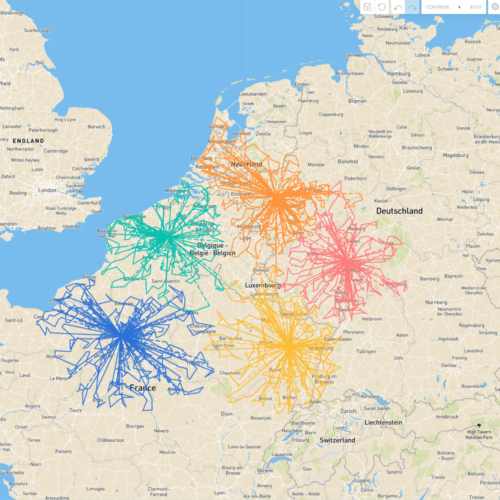Route optimization software for delivery operations
Transporting goods is becoming increasingly expensive due to rising fuel prices, supply chain volatility, and labor shortages. For companies in the transport and logistics industry, maintaining profitability without compromising service levels is a growing challenge. However, one of the most effective solutions to address this is route optimization technology.
Route optimization software like PTV OptiFlow, is a game-changer for businesses striving to improve efficiency and reduce costs. By automating the creation of optimized delivery routes, this technology allows businesses to save time, reduce fuel consumption, and enhance customer satisfaction. Moreover, as sustainability becomes more important, route optimization plays a crucial role in reducing environmental impact. For companies committed to both profitability and sustainability, route optimization is an essential tool.
Whether you’re considering implementing route optimization for the first time or are looking to maximize its potential, this article will explore how it can help reduce costs, improve efficiency, and contribute to a greener future.
What is Route Optimization?
Route optimization refers to the process of determining the most efficient paths for vehicles when delivering goods, taking into account factors such as time, distance, and cost. The primary goal is to streamline operations, reduce expenses, and ensure timely deliveries. However, route optimization can be complex, often requiring additional considerations like vehicle profiles, delivery time windows, product types, and driver preferences.
To navigate this complexity, businesses often rely on route optimization software, which uses advanced algorithms and mapping data to find the best combinations of pickups and deliveries. By considering real-time factors such as traffic, road conditions, and distance, route optimization software helps businesses save time, reduce costs, and improve overall efficiency.
How does a route optimization software work?
The process begins by gathering accurate data related to orders, vehicles, and drivers. This data can be manually entered into the software or automatically imported from a Transportation Management System (TMS) or Enterprise Resource Planning (ERP) system via an API integration. Once the data is in place, the next step is configuring the optimization settings. These settings can be adjusted based on fluctuating demands, seasonality, or other business-specific factors.
Once the settings are fine-tuned, the route optimization software takes over, generating an optimized plan. The planner can then review and compare different options before finalizing the route. Once the plan is approved, it can be seamlessly exported to drivers’ mobile devices or onboard computers for execution.
Route Optimization and Sustainability
In addition to improving operational efficiency, route optimization software contributes significantly to sustainability efforts. As businesses look for ways to reduce their environmental impact, many are adopting green practices like using alternative fuels, establishing strategic hub locations, and collaborating across the supply chain. Route optimization plays a key role in these efforts by reducing fuel consumption, lowering emissions, and ensuring that fleets operate in the most environmentally friendly way possible. Here’s how:
- Optimal load factor: Route optimization increases vehicle load efficiency, reducing the number of trips needed and thereby cutting down on fuel usage and emissions. By combining deliveries and collections, it maximizes vehicle capacity, optimizing every journey.
- Reduced time in traffic: Real-time and historical traffic data helps route optimization software avoid congested areas, minimizing time spent in traffic and reducing fuel wastage and CO2 emissions.
- Fewer kilometers driven: The software’s advanced algorithms plan the most efficient routes, cutting down on the total kilometers driven, which in turn reduces emissions.
- Flexibility for future needs: As regulations around emissions become stricter, route optimization helps businesses adapt, especially when transitioning to electric vehicles or planning for low-emission zones.

Who Can Benefit from Route Optimization Software?
Route optimization software benefits any business that relies on transportation for deliveries. From parcel services to laundry services, maintenance teams to food delivery companies, this technology ensures that businesses can manage multiple routes efficiently.
Industries such as food delivery, e-commerce, retail, waste collection, and pharmaceuticals have all seen significant improvements from route optimization. The right software depends on the complexity and size of your operations, as well as your specific industry needs.
What you stand to gain from Route Optimization
While manual route planning can deliver some advantages, route optimization software leverages powerful algorithms and real-time data to take these benefits to the next level.
- Lower transport costs
Route optimization helps reduce costs by creating more efficient routes. This means fewer miles driven, lower fuel expenses, and reduced vehicle and driver requirements. With route optimization software, the algorithm calculates the most cost-effective route, often delivering savings between 5% to 17%. - Better resource management
Efficient routes mean fewer vehicles are needed, which is crucial when drivers are in short supply. Route optimization software ensures optimal use of resources, whether it’s reducing idle time or extending the life cycle of vehicles through balanced workload distribution. - Improved customer satisfaction
Faster deliveries and fewer delays lead to happier customers. By factoring in real-time data and delivery windows, route optimization software makes it easier to meet customer expectations. It also simplifies returns, enhancing the overall customer experience. - Increased flexibility
Route optimization allows companies to adapt quickly to last-minute changes or disruptions, such as traffic jams. Software that processes real-time traffic data ensures that plans are updated in the moment, reducing delays and providing customers with more flexibility for their orders. - Elimination of manual processes
Route optimization software automates route planning, saving time and reducing the risk of human error. This frees up staff to focus on higher-value strategic tasks and speeds up the overall planning process. - Support for sustainability goals
Fewer miles and vehicles on the road mean a direct reduction in CO2 emissions. For companies with electric fleets, optimization software ensures the most efficient routes are used, increasing mileage per charge and factoring in charging points along the way. - Regulatory compliance
As environmental regulations tighten, especially in Europe, route optimization software helps businesses comply with low-emission zones by routing vehicles based on their emissions labels. It also assists in cross-border planning, accounting for various rules and restrictions like cabotage, which is increasingly important with international shipping.
How to Choose the Right Route Optimization Technology
Choosing the right route optimization technology requires careful consideration of your business needs and goals. Key factors to keep in mind are:
- Return on Investment (ROI): The more you’re willing to invest in route optimization technology, the closer you’ll get to an optimal solution. This can lead to faster deliveries, lower costs, and enhanced customer service, which supports both immediate profitability and long-term growth.
- Business needs: Assess the complexity of your operations. If your business handles multiple stops and large fleets, investing in sophisticated route optimization tools can provide significant savings. However, if you operate on a smaller scale, simpler, less expensive tools may suffice and prevent unnecessary costs.

- Integration with existing systems: It’s crucial that the route optimization tool integrates seamlessly with your current transport tech stack. Effective data exchange between systems minimizes manual processes and maximizes the efficiency of your operations.
- Environmental impact: Route optimization software isn’t just about cost savings, it also plays a significant role in reducing CO2 emissions. By increasing load factors, minimizing kilometers driven, and avoiding traffic jams, businesses can lower their environmental footprint while staying agile in response to external changes like new regulations.
- Overall benefits: Beyond fuel and labor cost savings, route optimization enhances operational efficiency and improves customer service. By reducing the risk of delivery delays and ensuring timely service, businesses can build stronger relationships with customers, ultimately supporting future growth and profitability.
At PTV Logistics, we understand the unique challenges businesses face, big or small. Our route optimization solutions are designed to support you, helping you streamline operations and reduce costs while improving service quality and environmental impact. Whatever your business needs, we’re here to help you find the right solution that fits.
Reach out to one of our experts here to get a customized solution.
